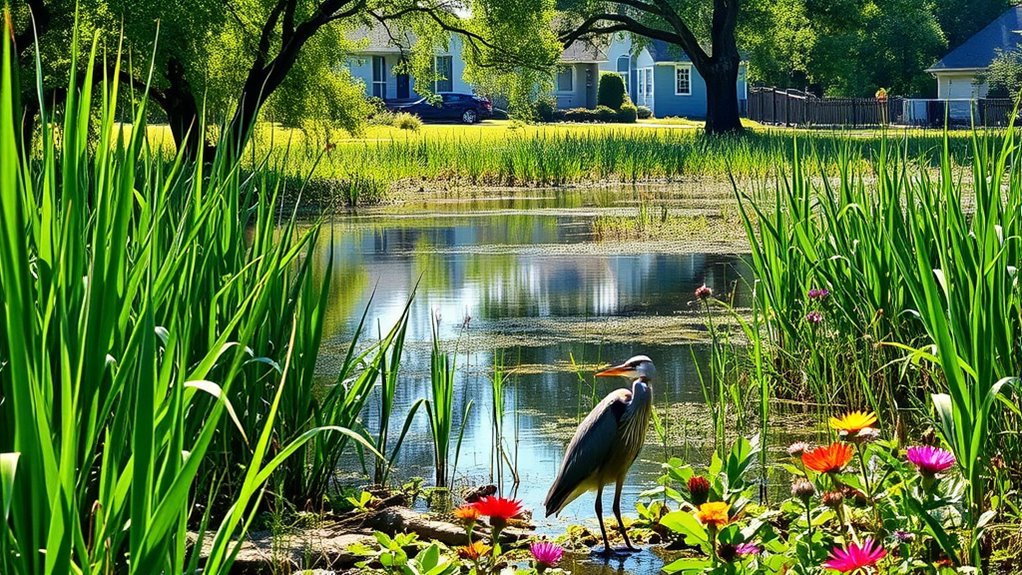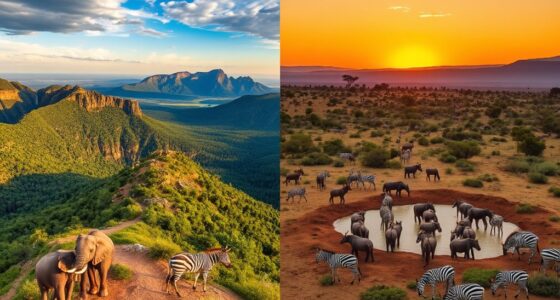Wetlands play vital roles in filtering water, supporting diverse ecosystems, and regulating the environment. They provide essential habitats for wildlife and can even help prevent floods. Unfortunately, wetlands face significant threats from development and climate change. To protect them, you can advocate for stronger environmental policies, participate in local restoration projects, and promote sustainable land-use practices. Want to explore more about how you can make a difference for these important ecosystems?
Key Takeaways
- Wetlands provide vital ecosystem services, enhancing water quality, supporting biodiversity, and acting as natural flood buffers.
- Protecting wetlands contributes to economic benefits, including commercial fishing and job creation in recreational activities.
- Community engagement and outreach programs are essential for raising awareness about the importance of wetlands and conservation efforts.
- Implementing restoration techniques, such as setback levees, can improve wetland habitats and biodiversity.
- Strong legislation and collaboration among stakeholders are crucial for effective wetland protection and restoration initiatives.
The Vital Functions of Wetlands in Ecosystems
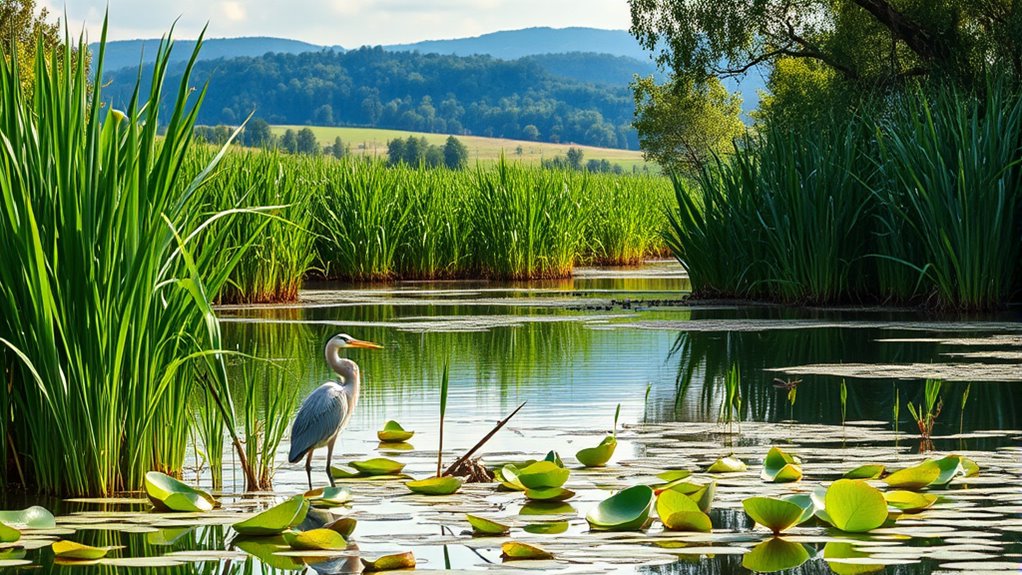
Wetlands play a crucial role in ecosystems, serving as biological supermarkets that support diverse life forms.
These rich environments provide essential food sources through detritus, feeding small aquatic insects and attracting various animal species throughout their life cycles. By offering habitats for fish and shellfish, wetlands sustain commercial fisheries that rely on these ecosystems. Wetlands also remove inorganic nutrients from surface runoff, which protects aquatic life and enhances overall water quality. Furthermore, they are considered biodiversity hotspots, which means they are rich in species diversity but are often threatened by human activities. The degradation of wetlands can lead to deforestation and loss of biodiversity, further exacerbating environmental challenges. Additionally, wetlands are essential for emotional regulation in many species, allowing them to thrive in their environments.
They’re among the most productive systems, contributing to energy storage and nutrient cycling. Additionally, wetland vegetation stabilizes soil, preventing erosion and maintaining water quality.
As natural sponges, wetlands control floods and store water, ensuring steady flows in nearby streams. By supporting these vital functions, wetlands not only enhance biodiversity but also bolster the health and resilience of the environments around them.
Wetlands and Biodiversity: A Critical Connection
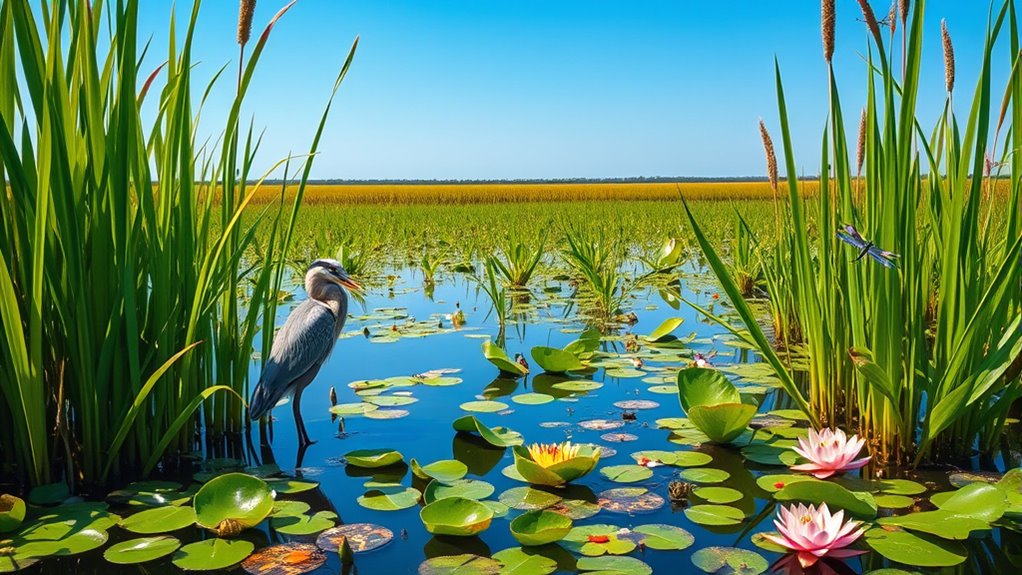
Across the globe, wetlands are vital ecosystems that support an astounding diversity of life. They’re home to about 40% of the world’s plant and animal species, including many endangered ones.
These unique habitats host over 100,000 freshwater species, with 200 new species discovered each year. Wetlands also provide essential stopover sites for millions of migratory birds and fish, facilitating their movement between habitats. Wetlands cover about 6% of the Earth’s surface, highlighting their significance in global ecology. Additionally, the high biodiversity found in wetlands fosters a greater resilience against environmental changes. Raw food diets can also promote healthier ecosystems by supporting natural food sources. Furthermore, the preservation of wetlands is crucial for the stability of ecosystems, as they serve as natural buffers against climate variability.
Different types of wetlands, like mangroves and peatlands, contribute significantly to marine biodiversity and carbon storage.
However, threats like habitat loss, pollution, and climate change endanger this rich biodiversity. By understanding these connections, you can appreciate the necessity of protecting and restoring wetlands to sustain the variety of life they harbor.
Economic Advantages of Wetland Conservation
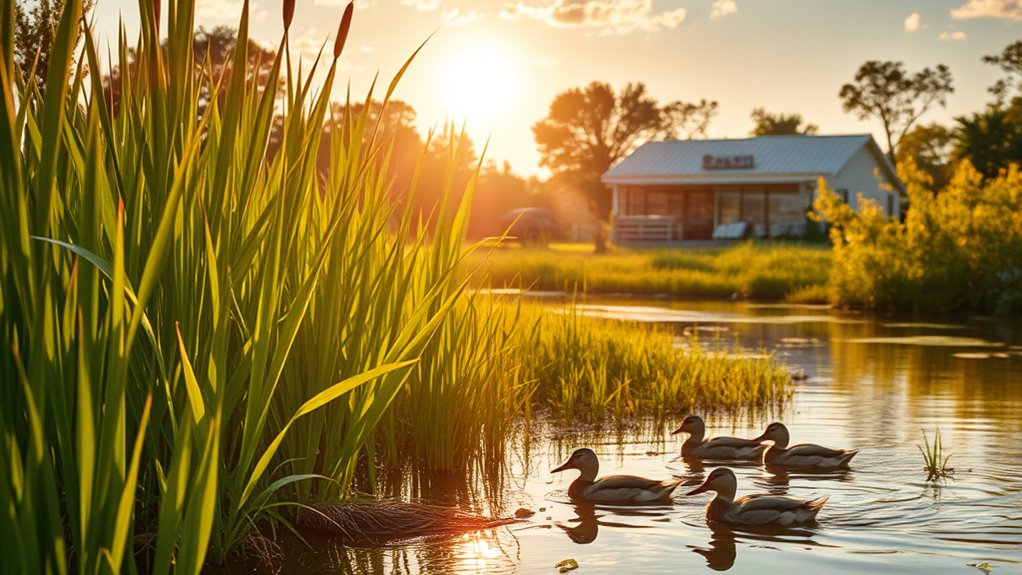
While many may overlook the economic value of wetland conservation, these vital ecosystems significantly contribute to global and local economies.
Wetlands are estimated to provide $14.9 trillion in ecosystem services worldwide. In the U.S. alone, commercial fishing, reliant on wetlands, adds about $1.2 trillion annually. Additionally, nearly half of bird species in the U.S. depend on wetlands for survival, highlighting their importance in supporting biodiversity and recreational activities. Wetlands also play a crucial role in natural water filtration, enhancing water quality and reducing treatment costs for communities. Furthermore, diversification of local economies can be achieved through sustainable practices that utilize wetland resources responsibly. Good grief is an emotional process that can lead to community resilience, which is often strengthened by the diverse ecosystems wetlands support.
They also generate jobs in the specialty foods and cosmetics industries while supporting recreational activities like birdwatching, which alone brings in nearly $10 billion.
Wetlands act as natural water filters and buffers against disasters, saving communities billions in potential damage.
Current Challenges Facing Wetlands

As human activities continue to encroach on natural landscapes, wetlands face numerous challenges that threaten their survival and ecological function.
Unsustainable development has led to the loss of over 87% of the world’s wetlands in the past 300 years, primarily for housing and agriculture. This development fragments habitats, impacting native species. Over a third of the world’s wetlands have disappeared due to such unsustainable practices. Additionally, long-term financial planning for conservation efforts is critical to ensure the protection of these vital ecosystems. The impacts of cybersecurity vulnerabilities during global disruptions highlight the importance of robust strategies to safeguard our natural resources. Imagination mobilizes mental potential, enabling innovative approaches to tackle these environmental issues.
Pollution from wastewater and pesticides overwhelms wetlands’ natural filtration, causing algal blooms and harming biodiversity. Additionally, invasive species disrupt ecosystems, outcompeting native flora and fauna.
Climate change further complicates matters, with altered rainfall patterns and rising sea levels threatening wetland integrity.
As you can see, these challenges not only jeopardize wildlife but also undermine the essential services wetlands provide to human communities.
Effective Strategies for Wetland Protection and Restoration
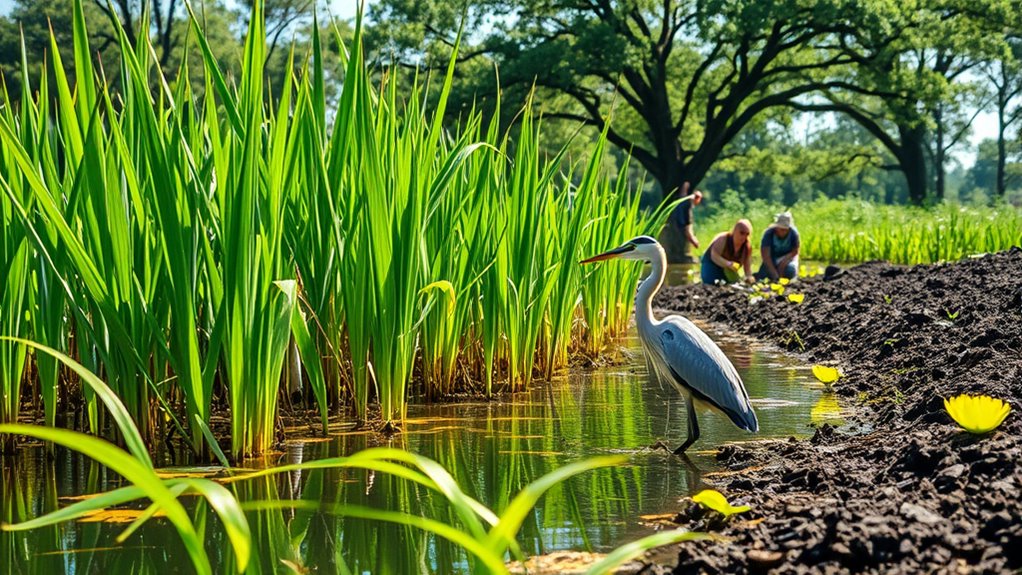
Wetlands are facing significant threats from human activities and environmental changes, making it vital to adopt effective strategies for their protection and restoration. You can help restore these ecosystems by supporting efforts that re-establish connectivity between rivers and floodplains. Techniques like building setback levees or using beaver dam analogues enhance water flow and improve habitat quality. Engaging in community outreach programs to raise awareness about the importance of wetlands and participating in local restoration projects is crucial for biodiversity support. Additionally, these efforts can contribute to inflation protection for local economies that rely on ecosystem services. Moreover, protecting wetlands can help mitigate the impacts of climate change by enhancing carbon sequestration capabilities. Natural elements from wetlands, such as plants and soil, play a crucial role in maintaining water quality and promoting biodiversity. Advocate for strong legislation, like the Ramsar Convention and the Clean Water Act, to safeguard these vital areas.
Frequently Asked Questions
How Do Wetlands Impact Local Climate Regulation?
Wetlands significantly impact local climate regulation by storing and releasing water, which influences temperature and precipitation patterns.
They act as natural buffers, absorbing excess water during heavy rainfall and helping to mitigate flooding.
The dense vegetation in wetlands cools the environment through evapotranspiration, maintaining local temperatures.
When you preserve wetlands, you support their role in regulating climate and protecting against extreme weather events, ultimately benefiting both the ecosystem and your community’s resilience.
What Role Do Wetlands Play in Flood Prevention?
Did you know a single acre of wetlands can store up to 1.5 million gallons of floodwater?
Wetlands play a crucial role in flood prevention by absorbing excess water and gradually releasing it, which helps lower peak flood heights. They act like sponges, reducing runoff into rivers and urban areas.
Can Wetlands Improve Groundwater Recharge?
Yes, wetlands can significantly improve groundwater recharge.
When you observe a wetland, you’ll notice how its unique soil structure allows water to infiltrate deeply, especially when the soil cracks during dry periods. This process creates pathways for water to reach underground aquifers.
How Do Wetlands Affect Nearby Agricultural Practices?
Imagine lush greens spilling over a tranquil pond, where the harmony of nature boosts your nearby crops.
Wetlands act like nature’s filters, reducing excess nutrients and pollutants from your fields, ensuring cleaner water flows into rivers.
They create a rich habitat, supporting biodiversity essential for healthy agriculture.
What Invasive Species Threaten Wetland Ecosystems?
Invasive species like Water Hyacinth and Spartina alterniflora threaten wetland ecosystems by outcompeting native plants for resources.
They can form dense mats, reducing biodiversity and disrupting water flow. You might notice how these invasives alter the natural habitat, making it harder for indigenous species to survive.
If left unchecked, they can transform vibrant wetlands into monocultures, which negatively impacts both the environment and local economies.
Awareness and proactive management are essential to combat these threats.
Conclusion
As you reflect on the vital role wetlands play in our world, consider the fragile balance they maintain. What if these ecosystems vanished? The loss would echo through biodiversity, economies, and our own lives. But it’s not too late. By championing conservation efforts and embracing restoration strategies, you can be part of a movement that protects these precious landscapes. Will you take action, or will the silence of disappearing wetlands haunt future generations? The choice is yours.
